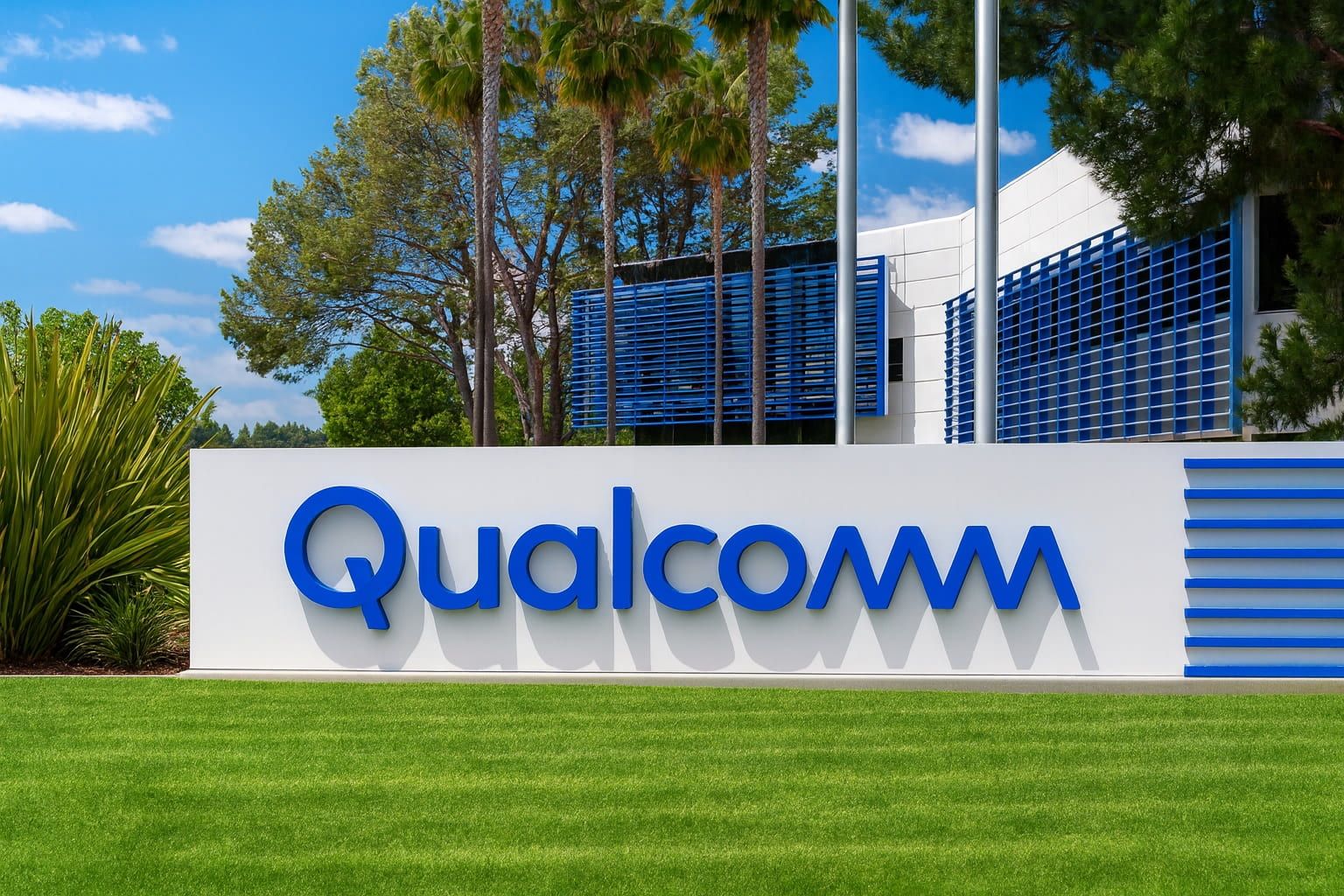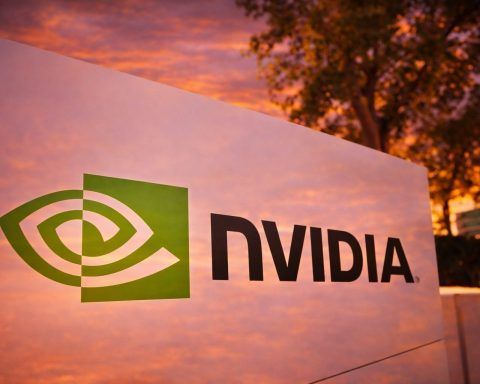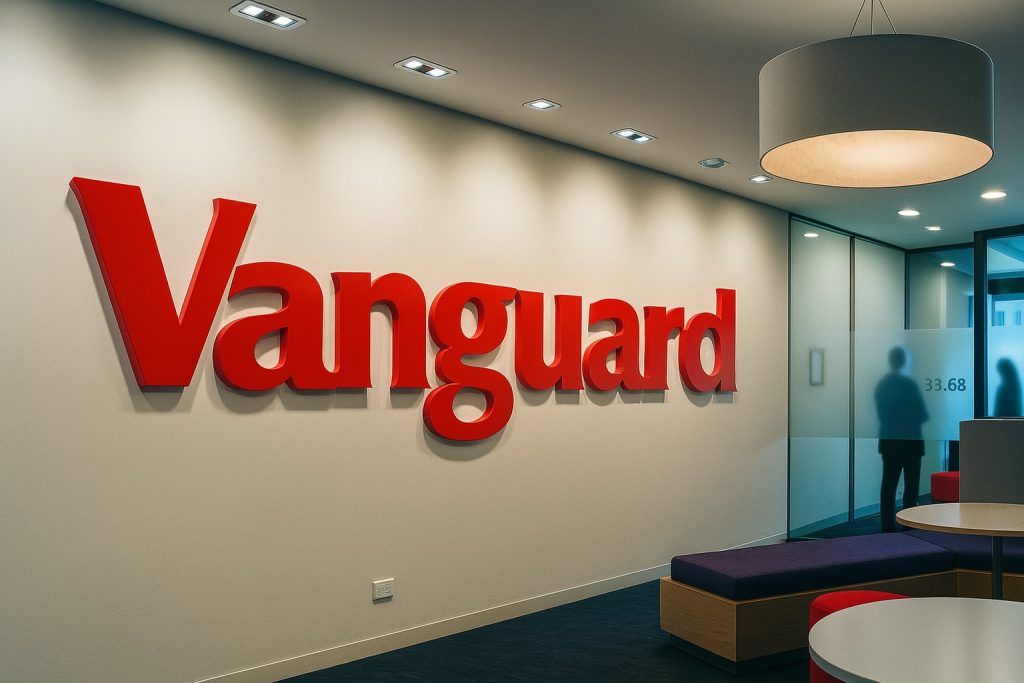- Qualcomm soars on AI push: Qualcomm (NASDAQ: QCOM) stock spiked to a new 52-week high (~$182) after unveiling powerful AI data-center chips designed to challenge Nvidia [1] [2]. Shares jumped double-digits (over +10%) on Oct. 27 as investors cheered Qualcomm’s expansion beyond smartphones into the booming AI hardware market.
- Institutions boost stakes: Major investors are increasing their Qualcomm holdings. Bessemer Group upped its position by 28.5% in Q2 (adding ~210,000 shares to hold ~$151 million worth of QCOM) [3]. The University of Texas/Texas A&M endowment fund (UTIMCO) bought ~11,995 Qualcomm shares (~$1.91 million) in Q2 [4], and Singapore’s OCBC Bank raised its stake by 51% (adding 9,635 shares) [5]. These moves signal rising institutional confidence in Qualcomm’s prospects.
- Solid earnings & dividend: Qualcomm last quarter beat expectations with EPS of $2.77 (vs. $2.71 forecast) on $10.37 billion revenue (+10.4% YoY) [6]. It issued a robust $0.89 quarterly dividend (next payable Dec. 18) – a 2.1% annual yield – rewarding shareholders [7]. The company’s net profit margins (~26–27% [8]) and high return on equity (~40% [9]) reflect strong profitability.
- Wall Street outlook: About 74% of QCOM’s stock is now held by institutions [10] [11]. Analysts broadly rate Qualcomm a “Moderate Buy,” with consensus 12-month price targets around $183 [12] (~8% above current levels). Several firms recently raised their targets to $200 after Qualcomm’s latest wins [13]. Bulls argue 5G, AI and automotive chips will drive growth, while bears warn of fierce competition and Apple’s looming shift away from Qualcomm modems [14].
- Value vs. risk: Despite recent gains, Qualcomm trades at ~16× earnings – far cheaper than peers like Nvidia (~55×) or AMD (~117×) [15]. Optimists see an undervalued opportunity if Qualcomm’s new initiatives pay off, whereas skeptics note the low valuation reflects uncertainty. Key risks include Apple developing its own iPhone modems by 2026–27 and geopolitical hurdles (e.g. a new China antitrust probe) that could weigh on Qualcomm’s future [16] [17].
Qualcomm Rallies on New AI Chips
Qualcomm’s share price is on the upswing after a headline-grabbing push into artificial intelligence hardware. On October 27, the San Diego-based chipmaker unveiled two AI accelerator chips (the AI200 and AI250) for cloud data centers, marking its formal challenge to Nvidia in this hot market [18]. The new chips – slated to ship in 2026–27 – are optimized for machine learning inference with massive memory capacity and efficiency. Qualcomm even introduced complete accelerator cards and server racks around these chips, touting industry-leading cost-performance for AI workloads [19] [20]. This strategic expansion beyond its traditional smartphone chips electrified investors: Qualcomm’s stock surged over 10% on the news, hitting ~$182 intraday [21].
This rally underscores how Qualcomm is reinventing itself for the AI era. The company has poured resources into data-center tech – including a $2.4 billion acquisition of UK-based Alphawave in June to bolster its connectivity IP for servers [22]. Qualcomm even struck a partnership to use Nvidia’s networking technology (NVLink) in its future chips, ensuring they can seamlessly interconnect with Nvidia GPUs in AI systems [23]. “The move represents Qualcomm’s strategic expansion beyond mobile chips into the rapidly growing data center AI market dominated by Nvidia,” notes Investing.com [24]. By committing to an annual cadence of AI chip improvements and leveraging its strength in efficient silicon design, Qualcomm is signaling it intends to be a serious contender in AI infrastructure, not just in smartphones.
Big Investors Are Betting on Qualcomm
It’s not just retail traders taking notice – large institutional investors have been quietly loading up on Qualcomm stock. Recent SEC filings reveal several big names boosted their QCOM stakes during the second quarter of 2025. Bessemer Group Inc., for example, increased its position by 28.5% last quarter, acquiring ~210,000 additional shares [25]. Bessemer now owns roughly 948,000 shares of Qualcomm (worth about $151 million), making it a notable stakeholder.
Another vote of confidence comes from academia’s investing arm: the University of Texas/Texas A&M Investment Management Co. (UTIMCO). UTIMCO purchased nearly 12,000 Qualcomm shares in Q2 (~$1.9 million worth), establishing a new stake in the chipmaker [26]. And overseas, Singapore’s Oversea-Chinese Banking Corp (OCBC) dramatically raised its Qualcomm holdings by +51%, adding 9,635 shares in the quarter [27]. OCBC’s total stake now stands at 28,432 shares (≈$4.51 million). These sizable additions suggest that sophisticated investors see value in Qualcomm at current prices. In total, hedge funds and institutions now own roughly 74% of Qualcomm’s float [28] [29] – a testament to how “big money” has confidence in Qualcomm’s trajectory.
It’s worth noting that while institutions have been accumulating, some insiders trimmed positions amid recent highs. Qualcomm’s CEO, Cristiano Amon, sold 150,000 shares of the company on Oct. 1 at an average ~$165.56 (a ~$24.8 million sale) [30]. That represented roughly half his holdings. Similarly, other executives sold smaller amounts over the summer [31]. Such insider selling can be routine profit-taking, but in Qualcomm’s case it also fueled debate: was management signaling anything? So far, the market appears unperturbed – with substantial institutional buying outweighing insider sales.
Earnings Beat and Shareholder Payouts Bolster Confidence
Another factor drawing investors is Qualcomm’s strong financial performance in 2025. Last quarter (fiscal Q3 2025), Qualcomm handily beat Wall Street expectations, reporting earnings of $2.77 per share (vs. $2.71 expected) [32]. Revenue came in at $10.37 billion for the quarter, up ~10.4% year-on-year [33] – a healthy growth rate for a mature chip company. Notably, Qualcomm’s net profit margin hit 26.8% and ROE topped 40% [34], underscoring the profitability of its business model. These results reinforced Qualcomm’s reputation for execution and cost management in a challenging environment. It also extended the company’s streak of earnings “beats” – a trend that has analysts hopeful for the upcoming Q4 earnings report in November.
Qualcomm has also been sharing the wealth with investors. The company announced it will pay a quarterly dividend of $0.89 per share on December 18, 2025, maintaining its practice of steady dividend hikes [35]. At the current stock price, that dividend yields roughly 2.1% annually – better than the S&P 500 average. Qualcomm’s dividend payouts are well-supported by its earnings (about a ~33% payout ratio) and the company has a history of annual increases [36]. Additionally, Qualcomm has engaged in share buybacks (over $5 billion repurchased in late 2024) [37], which signals confidence in its value. These shareholder returns make QCOM appealing as both a growth and income play – a rare combination in the tech sector. Indeed, as of October the stock’s 12-month gain was modest (~+4–5% [38]), but when factoring in dividends Qualcomm has delivered solid total returns and appears to be gathering momentum.
Financially, Qualcomm also sports a fortress balance sheet. It carries a moderate debt-to-equity ratio around 0.5 and healthy liquidity (current ratio ~3.2) [39]. This gives management flexibility to invest in new opportunities (like AI chips or automotive ventures) without jeopardizing stability. In short, Qualcomm’s recent performance and capital return policies paint the picture of a stable tech giant that’s still managing to grow – a profile that fund managers find attractive in volatile times.
Wall Street Raises Targets – $200 in Sight?
With Qualcomm’s stock rebounding and new growth drivers on the horizon, analyst sentiment has turned increasingly optimistic. The consensus rating remains a “Moderate Buy,” and price targets have been creeping upward. According to MarketBeat data, the average 12-month target for QCOM is about $183 per share [40], roughly where the stock trades after its recent rally. However, many analysts see considerably more upside. In fact, a set of fresh upgrades in October pushed the average target to $200 in one survey [41]. For instance, Susquehanna analysts raised their target to $200 (from $190) and reiterated a “Positive”/buy rating, citing Qualcomm’s improving outlook [42]. JPMorgan likewise boosted its target to $200 and kept an “Overweight” stance [43], while Benchmark Capital maintained a Buy rating and a $200 target, highlighting Qualcomm’s growth in automotive, IoT and handset divisions [44]. One of the more bullish calls comes from Rosenblatt Securities, which reiterated a $225 price target – implying confidence that Qualcomm can approach its mid-2024 all-time high if things go right [45].
Several catalysts underpin these upbeat forecasts. Analysts point to Qualcomm’s leadership in 5G – it remains the key modem supplier for smartphones globally (including Apple’s iPhones through at least 2026). Moreover, Qualcomm’s diversification into automotive chips is gaining traction: the company’s auto revenue jumped +21% year-on-year recently, thanks to design wins in car infotainment and ADAS (advanced driver assist) systems [46]. Its IoT (Internet of Things) segment is also booming (+24% YoY) [47], as Qualcomm’s connectivity and AI chips find new uses in smart devices, networking, and XR/AR wearables. Even the core handset chip business saw 7% growth [48], helped by premium Android phones adopting the latest Snapdragon 8 series chips. “The growth in auto and IoT is particularly encouraging,” noted a Benchmark analyst, as it shows Qualcomm can find new revenue streams beyond mobile [49]. With these tailwinds, multiple observers argue the stock “has room to run” – UBS recently upgraded QCOM to Neutral and lifted its target to $165 (after previously being bearish) [50] [51], and others have moved off the sidelines as Qualcomm proves it can execute in new arenas.
Of course, not every analyst is pounding the table just yet. A few remain cautious, keeping Hold or Neutral ratings and slightly lower targets (e.g. ~$175). Piper Sandler, for example, trimmed its target from $190 down to $175 despite an Overweight rating [52], reflecting some near-term uncertainty. “Low valuations aren’t always a green light – sometimes they signal doubt,” one MarketBeat commentator noted, adding that Wall Street wants to see more evidence of sustained growth before fully re-rating Qualcomm’s P/E higher [53]. Indeed, Qualcomm’s forward earnings multiple (~13×) is still roughly half that of high-flying peers, suggesting some skepticism persists [54] [55]. But if Qualcomm continues to beat expectations and deliver on its roadmap (AI chips, new Snapdragon launches, etc.), even the more conservative analysts acknowledge that upward revisions could follow. For now, the Street’s baseline view is that Qualcomm is a steady performer with upside potential – a stance that has clearly resonated with many institutional buyers.
Outlook: Growth Catalysts vs. Challenges Ahead
The road ahead for Qualcomm looks promising but not without challenges. On the bullish side, the company is firing on multiple cylinders of innovation. In mobile chips, Qualcomm just announced the Snapdragon 8 Gen 5 – billed as the world’s fastest smartphone processor – and it continues to supply nearly every major Android handset maker. At its Snapdragon Summit in October, Qualcomm also unveiled a Snapdragon X Elite PC processor that in early tests outperformed Apple’s M-series chip and Intel’s latest in certain benchmarks [56]. This aggressive push into laptop CPUs (set to hit devices in 2024) could open a new front against rivals and tap into the PC market with Arm-based chips. And now AI data centers are on the roadmap for 2026+, potentially unlocking a huge new TAM (total addressable market) if Qualcomm’s AI200/250 solutions gain traction [57]. In short, the company is leveraging its expertise in power-efficient, high-performance silicon across 5G, edge AI, automotive, IoT, and cloud – a strategy to reignite growth as smartphone unit sales globally plateau.
Another reason optimists are excited: Qualcomm’s valuation remains relatively low. Even after the recent rally to ~$180, QCOM trades around 15–16 times earnings [58] [59], which “looks like a bargain next to Nvidia at 50+ and AMD over 100×” earnings [60]. This suggests significant upside rerating potential if Qualcomm can deliver consistent growth. As one MarketBeat analyst put it, “With Qualcomm, you get the sense you could be early to the party, rather than late,” contrasting it with Nvidia’s already-euphoric pricing [61]. The company’s steady dividend (2+% yield) and buybacks also mean investors are paid to wait. Qualcomm’s healthy balance sheet and cash flows (TTM free cash flow > $11 billion [62]) give it ample room to invest in R&D and M&A to keep pace in fast-evolving tech arenas. These factors underpin the bull case that Qualcomm’s stock has more room to run in 2026 and beyond if its bets on AI and diversification pay off.
However, risks loom that temper the enthusiasm. Most prominently, Apple – Qualcomm’s largest customer for modems – plans to develop its own in-house 5G modem chips in the coming years, aiming to start phasing them into iPhones by 2026 or 2027 [63]. If Apple succeeds (a big “if”, given technical challenges), Qualcomm could eventually lose the multi-billion-dollar revenue stream from selling modems to Apple. Even with a recent extension of the supply agreement, this overhang weighs on long-term projections and is a key reason some analysts are cautious [64] [65]. Competition is another concern: in mobile processors Qualcomm faces an aggressive rival in MediaTek (especially in mid-range devices), in automotive it contends with Nvidia and traditional auto suppliers, and in the nascent AI server market it will battle giants like Nvidia, AMD and Intel. Qualcomm must execute near-flawlessly to carve out share in these areas.
Geopolitical and regulatory hurdles add further uncertainty. Nearly 46% of Qualcomm’s revenue comes from Chinese customers [66], which makes it vulnerable to U.S.–China trade tensions and Chinese regulators’ actions. This was highlighted on Oct. 10 when China’s SAMR abruptly launched an antitrust probe into Qualcomm’s $300M purchase of Autotalks, an Israeli auto-chip company [67]. That news sent QCOM stock down over 5% in one day [68]. Although the sell-off proved short-lived – the stock recovered as investors deemed the fears overdone – it was a stark reminder of Qualcomm’s exposure to political risk. “With Qualcomm deriving a notable portion of revenue from Chinese handset and auto customers, this announcement amplifies investor caution around geopolitical and regulatory risk,” one analyst observed of the Autotalks probe [69]. Export controls on advanced chips, tariffs, or further regulatory scrutiny in key markets remain an ever-present risk for all semiconductor firms, Qualcomm included [70].
All told, Qualcomm enters late 2025 with significant momentum. The stock’s recent climb to 52-week highs reflects a recognition that this once-sleepy tech giant is positioning itself for the next waves of growth. Big-money investors have taken notice, and many experts believe the market has underestimated Qualcomm’s resilience and innovation. As earnings season approaches, Qualcomm will have a chance to prove that its core business is steady and its new ventures can bear fruit. If it can navigate the challenges – from keeping Apple’s business as long as possible, to winning AI chip clients, to avoiding geopolitical landmines – Qualcomm could be poised for a breakout 2026. For now, the consensus is cautiously optimistic: Qualcomm looks like a fundamentally strong, undervalued leader at the nexus of 5G, AI, and mobile computing – and an increasing number of investors are betting that 2025’s wild ride was just the beginning of a longer uptrend [71] [72].
Sources: MarketBeat [73] [74] [75] [76]; Reuters [77]; Investing.com [78] [79]; TechStock² (TS2) [80] [81]; Benzinga [82].
References
1. www.investing.com, 2. uk.investing.com, 3. www.marketbeat.com, 4. www.marketbeat.com, 5. www.marketbeat.com, 6. www.marketbeat.com, 7. www.marketbeat.com, 8. www.marketbeat.com, 9. www.marketbeat.com, 10. www.marketbeat.com, 11. www.marketbeat.com, 12. www.marketbeat.com, 13. www.marketbeat.com, 14. ts2.tech, 15. www.marketbeat.com, 16. ts2.tech, 17. ts2.tech, 18. www.reuters.com, 19. uk.investing.com, 20. uk.investing.com, 21. www.investing.com, 22. www.reuters.com, 23. www.reuters.com, 24. uk.investing.com, 25. www.marketbeat.com, 26. www.marketbeat.com, 27. www.marketbeat.com, 28. www.marketbeat.com, 29. www.marketbeat.com, 30. www.marketbeat.com, 31. www.marketbeat.com, 32. www.marketbeat.com, 33. www.marketbeat.com, 34. www.marketbeat.com, 35. www.marketbeat.com, 36. ts2.tech, 37. ts2.tech, 38. www.investing.com, 39. www.marketbeat.com, 40. www.marketbeat.com, 41. www.benzinga.com, 42. www.benzinga.com, 43. www.benzinga.com, 44. www.investing.com, 45. www.benzinga.com, 46. www.investing.com, 47. www.investing.com, 48. www.investing.com, 49. www.investing.com, 50. www.marketbeat.com, 51. www.marketbeat.com, 52. www.benzinga.com, 53. www.marketbeat.com, 54. www.marketbeat.com, 55. www.marketbeat.com, 56. ts2.tech, 57. uk.investing.com, 58. www.investing.com, 59. www.investing.com, 60. www.marketbeat.com, 61. www.marketbeat.com, 62. finance.yahoo.com, 63. ts2.tech, 64. ts2.tech, 65. ts2.tech, 66. ts2.tech, 67. ts2.tech, 68. ts2.tech, 69. ts2.tech, 70. ts2.tech, 71. www.marketbeat.com, 72. www.marketbeat.com, 73. www.marketbeat.com, 74. www.marketbeat.com, 75. www.marketbeat.com, 76. www.marketbeat.com, 77. www.reuters.com, 78. www.investing.com, 79. uk.investing.com, 80. ts2.tech, 81. ts2.tech, 82. www.benzinga.com







